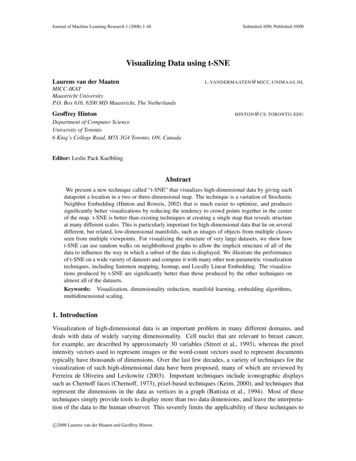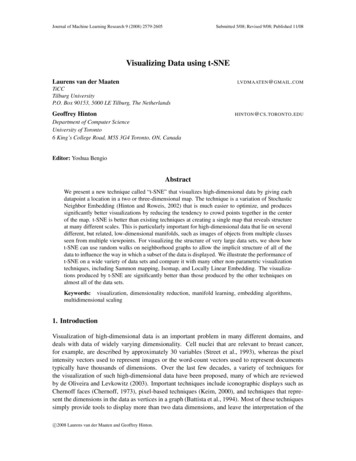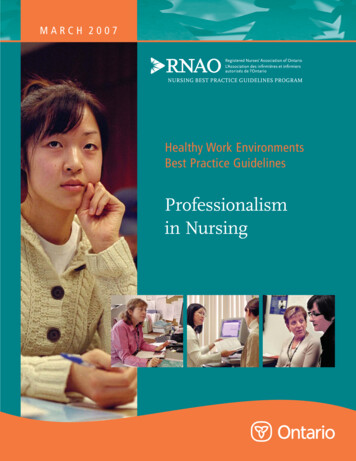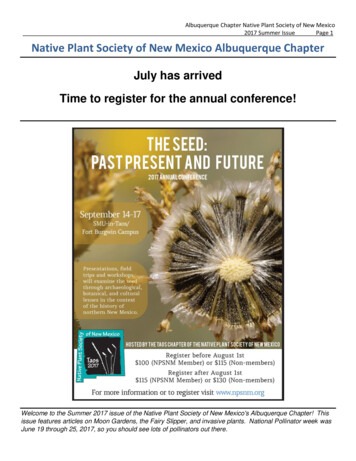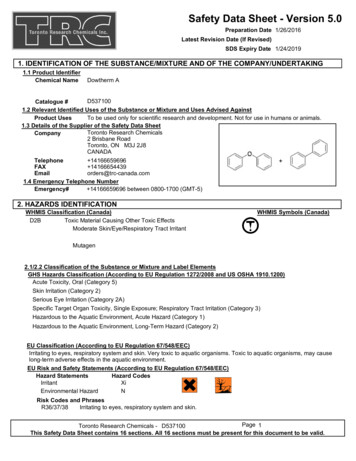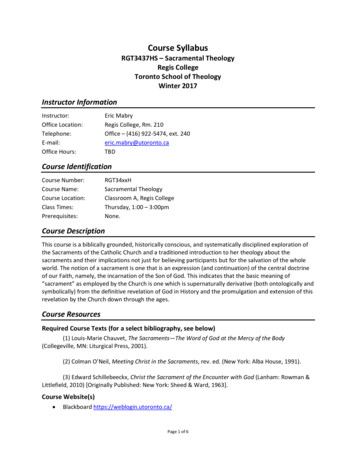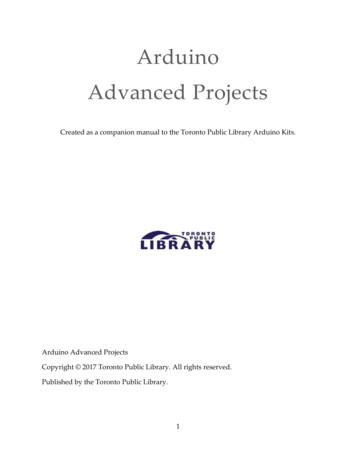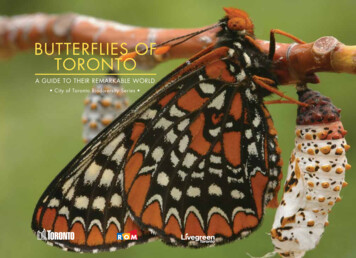
Transcription
BUTTERFLIES OFTORONTOA GUIDE TO THEIR REMARKABLE WORLD City of Toronto Biodiversity Series
Imagine a Toronto with flourishing natural habitats and anurban environment made safe for a great diversity of wildlifespecies. Envision a city whose residents treasure their daily encounterswith the remarkable and inspiring world of nature, and the variety ofplants and animals who share this world. Take pride in a Toronto thataspires to be a world leader in the development of urban initiativesthat will be critical to the preservation of our flora and fauna.Cover photo: Kerry Jarvis, www.kerryjarvis.comThe exquisite orange, white and black markings of the Baltimore Checkerspotmake this one of the most vibrant and beautiful butterflies to behold. These telltalecolours are evident in the pupa and adult stages. The Baltimore Checkerspot isfound in wetland areas where its caterpillar host plant turtlehead occurs. Whenthey are nearly full-grown, the caterpillars leave their host en masse to overwinterin the leaf litter below, and emerge in early spring to continue feeding. Then, themagic of metamorphosis takes place. This image captures the beauty of both thenewly-emerged adult and chrysalis in all their glory.City of Toronto 2011ISBN 978-1-895739-62-6Bronze Copperphoto: Mike Gurr
“Indeed, in its need for variety and acceptance of randomness, a flourishingnatural ecosystem is more like a city than like a plantation. Perhaps it will bethe city that reawakens our understanding and appreciation of nature, in allits teeming, unpredictable complexity.” – Jane JacobsGreat Spangled Fritillaryillustration: Susan Boswell“May the wings of the butterfly kiss the sun and find your shoulder to light on,To bring you luck, happiness and riches today, tomorrow and beyond.”– Irish Blessing1TABLE OF CONTENTSWelcome from Margaret Atwood and Graeme GibsonIntroduction to the Butterflies of Toronto . . . . . . .Joy of Butterfly Watching . . . . . . . . . . . . . . . . . .Ojibway Legend – “The First Butterflies” . . . . . . . . .Early Toronto Entomologists . . . . . . . . . . . . . . . .Toronto’s Plant Communities . . . . . . . . . . . . . . . .Insect/Plant Co-evolution . . . . . . . . . . . . . . . . . .Butterfly Identification . . . . . . . . . . . . . . . . . . . .Butterfly Biology and Life Strategies . . . . . . . . . . .Threats to Butterflies – Natural Enemies . . . . . . . .Threats to Butterflies – Human Effects . . . . . . . . . . 2. 2. 3. 4. 5. 6. 7. 8101214Butterflies of Toronto . . . . . . . . . . . . . . . . . . . . . . . . . . .Toronto’s (un)Official Butterfly: Eastern Tiger SwallowtailMonarch . . . . . . . . . . . . . . . . . . . . . . . . . . . . . . . . . .Resident Butterflies . . . . . . . . . . . . . . . . . . . . . . . . . .Range Expansions . . . . . . . . . . . . . . . . . . . . . . . . . . .Annual Migrants . . . . . . . . . . . . . . . . . . . . . . . . . . . .Historical Records . . . . . . . . . . . . . . . . . . . . . . . . . . .Infrequent Migrants . . . . . . . . . . . . . . . . . . . . . . . . . .Toronto Habitats . . . . . . . . . . . . . . . . . . . . . . . . . . . .Extirpated Species . . . . . . . . . . . . . . . . . . . . . . . . . . .16161824313232333738Checklist of the Butterflies of the Toronto Area (2011) .A Chronology of the Toronto Butterfly Year . . . . . . . .Exceptional Butterfly Viewing Locations in Toronto . . .Humber Bay Butterfly Habitat . . . . . . . . . . . . . . .High Park . . . . . . . . . . . . . . . . . . . . . . . . . . . . .Leslie Street Spit/Tommy Thompson Park . . . . . . .Rouge Park . . . . . . . . . . . . . . . . . . . . . . . . . . . .Annual Butterfly Counts . . . . . . . . . . . . . . . . . . . . .Local Policy Initiatives . . . . . . . . . . . . . . . . . . . . . .How You Can Help . . . . . . . . . . . . . . . . . . . . . . . . .Plants Used by Butterflies and Caterpillars . . . . . . . . .Conclusion . . . . . . . . . . . . . . . . . . . . . . . . . . . . . .Select Butterfly Resources . . . . . . . . . . . . . . . . . . . .Acknowledgements . . . . . . . . . . . . . . . . . . . . . . . . .4042444647484950525457606165.
2Welcome!Introduction to the Butterflies of TorontoTo encourage the celebration of all life on earth, the United Nationsdeclared 2010 to be the Year of Biodiversity. We congratulate theCity of Toronto for honouring this special year with this BiodiversitySeries celebrating the flora and fauna of our city. Each booklet withinthe series – written by dedicated volunteers, both amateurs andprofessionals – offers Torontonians a comprehensive look at a majorgroup of flora and fauna within our city.In Toronto, we are often unaware of the myriad variety of life rightin our own backyards. These species sometimes flourish or declinebased on our activities and how we care for the local ecosystemsin our trust. Butterflies of Toronto is not a field guide in the typicalsense, but aims to share with you the expertise of local butterflywatchers (lepidopterists), scientists, conservationists and city planners.Inside you will find profiles of some of our most beautiful species, achecklist and images of all those you may see, where you can go tosee them, threats to their survival, and what you can do to help themthrive in our wonderful city. From the stunning re-invention of self,represented by complete metamorphosis from egg to butterfly, tothe prodigious migration of Monarch butterflies from Toronto toMexico, you will gain a new appreciation for these resplendent,remarkable insects. This book will inspire you, as it has me, toadmire butterflies not only for their beauty but also for their tenacityfor survival in an ever-changing environment. I, for one, have brokenout a new pair of binoculars and been converted to the ranks of theavid lepidopterist! Happy butterfly viewing!We hope that this Biodiversity Series will achieve its main goal: tocultivate a sense of stewardship in Toronto area residents. If each ofus becomes aware of the rich variety of life forms, their beauty andtheir critical roles within the varied ecosystems of Toronto, we willsurely be inspired to protect this natural heritage. After all, our ownhealth and ultimately our very survival is linked to the species andnatural spaces that share the planet with us. Without plants, therewould be no oxygen; without the life of the soil, there would be noplants; without unpolluted fresh water, we would die.While there are many organizations actively engaged in protectingour city’s flora and fauna, the support of ordinary citizens is critical tothe conservation of our natural habitats. We hope you’ll take a walkin one of our parks and open spaces, lower your blood pressure, lookaround you, and enjoy thediversity of trees, animals,birds, flowers, and even fungithat flourish among us.With best wishes,Margaret Atwood andGraeme GibsonJanuary 2011Yours truly,Dr. Mark D. EngstromDeputy Director, Collections and Research, Royal Ontario MuseumCity of Toronto Biodiversity SeriesButterflies of Toronto is part of the Biodiversity Series developed by theCity of Toronto in honour of the Year of Biodiversity 2010. A number ofthe non-human residents of Toronto (defined here as a 50 km radius fromthe Royal Ontario Museum) will be profiled in the Series. It is hoped thatdespite the severe biodiversity loss due to massive urbanization, pollution,invasive species, habitat loss and climate change, the Biodiversity Serieswill help to re-connect people with the natural world, and raise awarenessof the seriousness that biodiversity loss represents and how it affects themdirectly. The Series will inform residents and visitors of opportunities toappreciate the variety of species inhabiting Toronto and how to helpreduce biodiversity loss by making informed individual decisions.
3Joy of Butterfly WatchingButterflies! Colourful and beautiful, they are many people’s favouriteinsects. Lepidoptera, meaning “scaly wings,” is the name for theorder of butterflies and moths. Butterflies’ vibrant colours come fromthe many individually coloured scales on their wings. In years past,lepidopterists (people who study butterflies) were mostly collectorswho sought out the most beautiful and sometimes rare specimens fortheir butterfly collections. Today, we are much more aware of ourimpact on the environment and try to reduce that impact. Those wholove and enjoy butterflies observe them in their native environment,take pictures and sometimes catch them for close examination beforereleasing them.Why are we so fascinated with butterflies? It could be their colourfulbeauty or their transformation from a caterpillar to a chrysalis to amagical winged creature. Every young child is mesmerized by themetamorphosis that they (and scientists) only poorly understand.These delicate creatures remind us that positive change is possibleand bring us hope. Observing butterflies brings us closer to nature. Ifwe admire them, know them and love them, then maybe we will takemore care of the environment (even in a big city) that we share.Populations of butterflies in Toronto are relatively small and shouldnot be collected. As of 2011, 110 species have been recorded from theToronto area. Of those, at least one is extirpated (locally extinct) anda few were only ever recorded a couple of times over the last 150 years.If you do catch a butterfly for observation, please treat it gently andrelease it immediately. Please report any unusual butterfly sightings tothe Toronto Entomologists’ Association at www.ontarioinsects.org.May you be inspired to look more closely at the world around youfor these most beautiful animals. Follow the erratic flight of some ofnature’s most delightful citizens; observe them wherever you may be,in a garden, a park, or a field and enjoy the fleeting time that youhave together!Tips for butterfly watching: Bring your binoculars on a hike so you can view them up close. A field guide may help you to identify butterflies and learn their foodplants. Look for the specific host plants and check them for eggs orcaterpillars. Use a notebook to write down observations (it will help you to learnthe differences between species).Photographing an Eastern Commaphoto: Antonia Guidotti Bring a camera and take pictures (you can try to identify the butterflylater using other references).
The First ButterfliesReprinted with the permission of the Royal Ontario Museum,from Tales the Elders Told – Ojibway Legends by Basil Johnson.Long ago, when human twins were born to SpiritWoman, she relied on the animals to help her takecare of them. All the animals loved the first humanbabies and did everything they could to help them.The dog watched over them. The bear gave his fur tokeep them warm. The wolf hunted for them. The doeprovided them with milk. The beaver and the muskratbathed them. The birds sang lullabies to them. Thedog was an excellent guardian. The twins had onlyto cry out and the dog jumped to his feet, his tailwagging. When he found out what was troubling thechildren, he set it right – or called someone else whocould help.Did the babies need fresh moss to keep themcomfortable? The dog appealed to the muskrat andthe beaver. Were the babies hungry? The dog ranto the wolf, or to the doe who gave the babies hernourishing milk. Were the flies bothering the infants?The dog asked the spider for help – or jumped andsnapped at the pests until the babies laughed.When the babies wanted to be amused, the dog didhis best tricks for them. He rolled over, he sat up, hewagged his tail. He tickled the babies into delightedlaughter by licking their noses. Whenthe babies were quiet again, the dogsank down beside them and coveredhis eyes with his paws – to rest untilhe was needed again.After a long time, it became clearthat something was wrong with thechildren. The worried animals, whohad been summoned by the bear,gathered round the twins.“Brothers,” said the bear,“the children cannot walk.They do not run and play asour young do. What can wedo to help them?”The wolf spoke first. “Theyeat the meat I bring them.They are not weak.”The doe agreed. “Every daythey drink milk.”The beaver and the muskrat told the other animalsthat the twins waved their arms and legs with greatstrength at bath time. Indeed, they often splashedand splashed until the beaver and the muskrat weresoaked and out of patience. Then the twins laughedas if they understood what they had done. They wenton waving their arms and legs as the fish had taughtthem to do.When Nanabush came to play with the children,the animals told him of their concern. Nanabushthought awhile and then he said, “You have caredfor the children very well. In fact, you have caredfor them so well that they never need to do anythingfor themselves. All little ones need to reach out forwhat they want instead of always having everythinghanded to them. I shall find out what we can do tohelp the babies learn to walk.”Nanabush journeyed far to the westto the land of high mountains, wherethe cloudy peaks stretch up to thesky. From the towering heights, hecalled to the Great Spirit who wasthe creator of the children and hadbeen watching over them. The GreatSpirit would know what should bedone to teach the children to walk.In reply to Nanabush’s call,the Great Spirit told him tosearch along the slopes of themountains. There he wouldfind thousands of tiny sparklingstones. Nanabush did as theGreat Spirit had said. He collectedhundreds of stones – blue ones andgreen ones and red ones and yellowones. Soon he had a huge pile thatgleamed through the clouds.Nanabush squatted beside the pile of colouredstones and watched them for a long while – butnothing happened. At last Nanabush grew boredand restless and began to toss the stones, one afteranother, into the air. As the stones fell back to earth,he caught them.Then he tossed a handful of stones into the air,catching them as they fell back. He threw a secondhandful, but this time nothing dropped back into hisoutstretched hands. Nanabush looked up. To hisastonishment, he saw the pebbles changing intowinged creatures of many colours and shapes.The beautiful creatures fluttered here and therebefore they came to nestle on Nanabush’s shoulders.Soon he was surrounded by clouds of shifting colours.And these were the first butterflies.The butterflies followed Nanabush back to the twins,who crowed with pleasure and waved their legs andstretched out their arms to the beautiful creatures. Butthe butterflies always fluttered just beyond the graspof the small outstretched hands. Soon the twins beganto crawl, and then to walk, and even to run in theirefforts to catch the butterflies.
5Early Toronto EntomologistsIn Toronto’s younger years, many naturalists were primarily birders,with very few active in entomology. However, there were somenotable pioneering entomologists in Ontario and their contributionswere considerable. While most of them did not have formalentomological training, some became professionals and many ofthem studied and collected butterflies at some point in their lives.William Couper is one of the first noted entomologists who lived inToronto in the mid-1800s. Although he is known for his descriptionsof beetles, the butterfly Glaucopsyche lygdamus couperi (Silvery Blue)was named after him. He was one of the founders of theEntomological Society of Canada/Entomological Society ofOntario and the Entomological Society of Quebec.Reverend Charles J.S. Bethune (1838-1932) was also one of thefounders of the ESC/ESO, in addition to being the first editor of thejournal Canadian Entomologist. He also established an entomologyprogram at the Ontario College of Agriculture (now part of theUniversity of Guelph) in the early 20th century. He collectedbutterflies from eastern Canada.Reverend J.C.E. Riottephoto: Brian Boyle ROMDr. William M. Brodie, the first Provincial Biologist of Ontario from1903 to 1909, was an avid collector. Some of his insect and birdcollections reside in the Royal Ontario Museum. In 1877, he was thefounding president of the Toronto Entomological Association whichbecame the Natural History Society of Toronto and then part of theRoyal Canadian Institute (not the same as the present day TorontoEntomologists’ Association).Arthur Gibson’s collection of Lepidoptera provided the basis forthe list of 79 butterflies in the Natural History of the Toronto Region,published in 1913 by the Royal Canadian Institute. This compilationwas remarkable for its time, especially since Gibson lived in Ottawa.A ROM research associate from 1962-1975, the late ReverendJ.C.E. Riotte was one of the founding members of the TorontoEntomologists’ Association and briefly, an editor of OntarioLepidoptera (an annual summary of butterfly counts). He was anavid lepidopterist who published extensively about moths.Other Toronto butterfly collectors of note include Paul Hahn,T. Irwin, C.E. Hope, W.M.M. Edmonds, and Quimby Hess.The Toronto Entomologists’ Association (TEA) was founded in 1967 by Rev. J. C. E. Riotte. Initially, there wereonly three members (and their spouses) from the Department of Entomology at the Royal Ontario Museum (ROM).This founding meeting took place in High Park on September 17, 1967. In the early years (circa 1969), thefocus of the TEA was on insect collecting and the exchange of specimens by members. However, the TEA haschanged considerably over time, and has grown to reflect the diverse and evolving interests of insect enthusiasts.The TEA has many environmentally conscious members who are focused on theobservation and preservation of insects in their natural environment. With theadvent of digital technology, “insect photography” has replaced “collecting” asthe main focus of the TEA. www.ontarioinsects.org
6Toronto’s Plant CommunitiesToronto lies at the junction of two vegetationregions, the Carolinian Zone and the GreatLakes-St. Lawrence or Mixed Forest Zone.High Parkphoto: Bob YukichThe Carolinian Zone, covering most ofsouthwestern Ontario, is a continuation ofthe deciduous forest that extends south tothe Carolinas in the U.S. It is composed of awide spectrum of broad-leaved deciduous trees(maples, oaks, beech, tulip tree, sassafras andhickories) with an understory of tall shrubs.Historically, dense forest was interspersed withpockets of grasslands – tallgrass prairie and oaksavannah lush with wildflowers and grasses.High Park is a remnant oak savannah.Much of Toronto and the regions to the eastand north lie within the Great Lakes-St. Lawrence or Mixed ForestZone. These forests are transitional between the conifer-dominatedboreal forests to the north and the deciduous forests to the south.They are composed of conifers and deciduous trees, especially maples,oaks, beech, white pine and hemlock, and havean understory of low shrubs.Toronto’s position at this vegetation crossroads,along with its terrain, watersheds and shorelines,has afforded it a diverse flora which in turnattracts and supports a diversity of butterfliesand other wildlife. Prior to Europeansettlement, wetlands lined the shores of LakeOntario and all of the rivers. The TorontoIslands were covered by dunes, sand prairie,wet meadows and poplar groves. Uplandregions supported forests of oak and pine,hickory, maple, beech and hemlock. Forestry,agriculture and urban development have sincediminished these habitats. However, remnantsstill survive in the city’s ravines and parkland,forming green corridors for wildlife. Maintenance of these corridorsand the diversity of native plant species within them is important forbutterfly conservation and is an important focus for all conservation,restoration and planting projects.Invasive Plants – Invasive plants are introduced species that survive without human assistance and negatively impact native biodiversity by reproducingaggressively and taking over, to the exclusion of other plants. They have the potential to interfere with native plant communities because they are highlysuccessful at growth and reproduction. Most invasive plants in Toronto were introduced intentionally as garden plants and have escaped their gardenboundary. When native species are displaced by invasives there are inevitable impacts on the fauna that rely on them. While some fauna have aremarkable capacity to adapt to changes in the plant communities that form their habitat, others cannot. Most adult butterflies respond favourably toexotic nectar-producing plants, and certain caterpillars can adapt to use non-native plants within the same plant family. However, since native butterflieshave evolved alongside native plants, the loss of a caterpillar’s native host plant can mean the loss of the butterfly in that area. The negative impact ofinvasive species on biodiversity is second only to habitat loss, so it is best not to plant invasive plants in your garden, especially if you live near a ravineor other natural area.
7Insect/Plant Co-evolutionThe wonderful diversity of life on our planet can be attributed,in part, to co-evolution between plants and insects. Co-evolutionhappens when a change in one species affects or triggers a change inanother species. Millions of years ago (during the Cretaceous period),a burst in insect evolution was fuelled by the rapid diversification offlowering plants. Some amazing partnerships have evolved. Insect/plant associations can be found virtually everywhere in nature.Approximately half the species of known insects feed on plants.The caterpillars of all Toronto butterflies except one, the Harvester,feed on plants. Caterpillars are specialists; that is, each species feedsexclusively on one or several closely related species of plant.Examples of Insect/Plant Co-evolution: The co-evolution of Monarch caterpillars and milkweeds is well known. The Karner Blue/wild lupine dependence provides a dramaticexample of what can happen when the host plant is lost from itshabitat (see page 38). Cabbage plants and their relatives have evolved a very powerfulchemical defense system, called glucosinolates (mustard oilglucosides), to keep away herbivores. Studies on the CabbageWhite (Pieris rapae) have identified the specific gene that detoxifiesglucosinolate chemical defenses. Some other Pieris species are alsoable to detoxify these chemicals.Plants evolve traits, like toxins or spines, to help protect them againstattack by herbivorous insects. But insects counterattack by developingstrategies to overcome the plant’s defences, such as a resistance toplant toxins. The ongoing evolution/counter-evolution strugglebetween insects and plants is sometimes called an “evolutionaryarms race,” with each partner developing measures to counteract theother. While most plants thrive in the absence of herbivorous insects,butterflies cannot survive without their host plants.Some flowering plants have evolved particular odours, colours andshapes to attract specific pollinating insects. The most effectivepollinators are those that consistently visit flowers of the same plantspecies. However, most adult butterflies are generalists that flutterfrom flower to flower and plant to plant, sucking nectar wherever theyencounter it. This makes them incidental pollinators since they rarelyfeed on flowers of only one plant species.Cabbage White caterpillar feeding on cultivated broccoliphoto: Glenn Richardson
8Butterfly IdentificationMost people learn to identify a butterfly by a commonly used name(e.g., Monarch, Painted Lady). This may pose problems with a fewbutterflies that have a very wide distribution and are known bymore than one common name. However, the scientific binomialname (Genus and species) is the same the world over. In the specieslist provided in this booklet, you will find butterflies listed by boththeir local common names and their scientific names. (Butterflieswill often be given a subspecies name as well. One species that maybe very widespread may be given different subspecies names indifferent geographic areas. Since subspecies are assumed to be able tointerbreed, we have not included this information here.)How do you identify a butterfly? The principal characters used inidentifying adult butterflies are colour, size, patterns and wing shape.However, closely related species can be very similar in size and shape;they may be so similar that even experienced butterfly watchers havedifficulty distinguishing one from the other. Sometimes, location andtime of year also help to determine a species. For example, the SpringAzure is found in April, May and early June while the Summer Azureemerges later in the season. Behaviour can sometimes be used todifferentiate butterfly species in the field. How and where they fly, andtheir proximity to certain plants may help to separate one species fromanother. While this booklet may help you identify some species, usinga butterfly guidebook is recommended.One example of a difficult-to-identify group is the Spring Azurecomplex. Are there three, four, five or six species? Is it one species inOntario and another in eastern Canada and yet another in B.C. andAlberta? Are they able to interbreed? With the Azures, it isn’t just thatthey are difficult to identify, but that it is uncertain how many speciesRelative sizesAll images are life-size. Sizes may vary according to gender and season of brood.Cabbage WhiteWild Indigo DuskywingLittle Wood-SatyrEastern CommaMourning Cloak
9there are exactly. Lepidopterists who study this group have beenconfused by them for a long time. The Summer Azure was thought tobe a second brood of the Spring Azure but is now considered its ownspecies. This example shows that it is not always easy to determineexactly what the “species” may be.Summer Azure, malephoto: Glenn RichardsonMonarchEastern Tailed-BlueCrossline SkipperPearl CrescentAmerican LadyAcadian HairstreakDNA barcoding is a method that uses a piece of an organism’s DNA toidentify it as belonging to a particular species. A species needs to havebeen described and known for this to work. An effort is being made tobarcode all living species. Barcodes are sometimes used in an effort toidentify unknown species or assess whether species should be combinedor separated (i.e., is it one species or two?). While it may be a helpful toolin some particular cases, the scientific community is divided regardingthe merit of using barcoding to identify new and cryptic species. Onepotential use may be to identify life stages that are presently unknown.
10Butterfly Biology and Life StrategiesBasic biologyButterflies – and this seems to come as a surprise to some – are insects.Insects are invertebrates, meaning their skeleton is on the outside.They have six legs, three body parts (head, thorax and abdomen),antennae, and wings in at least one stage. Butterflies smell with theirantennae and taste with their feet. Through their proboscis, adults sipnectar from flowers. The wings of butterflies receive their colour fromtheir covering of tiny scales. Caterpillars, the larval stage of butterflies,only have six jointed legs, any other “legs” are calledprolegs; they are fleshy.Stage 4: AdultA butterfly’s body temperature is influenced by the sunand the ambient temperature. Since they are coldblooded, when the temperature drops their bodytemperature drops and they slow down. They mayvibrate their wings to increase their temperatureon cooler days or they may bask in the sunshinein order to warm up. While caterpillars are mostlyplant eaters, adult butterflies are liquid feeders. Theymay feed on nectar, sap, mud, rotting fruit, carrion ordung. They don’t sip nectar from only one type of flower;they will visit many different ones. Although butterflies havebeen widely praised for their importance in pollination,their contribution is actually minimal and incidental.“There is nothing in a caterpillar thattells you it’s going to be a butterfly.”– R. Buckminster FullerLife CycleStage 1: EggStage 2: Caterpillar (larva)Stage 3: Chrysalis (pupa)Life historyButterflies, as most elementary school children learn, undergo aseemingly magical change called “metamorphosis.” Female butterflieslay anywhere from a hundred to a few thousand eggs in their lifetime.They lay eggs on plants that will serve as food for the newly hatched,photos of Black Swallowtail: Glenn Richardson
11worm-like caterpillars. The tiny caterpillareats plants ravenously (except for theHarvester whose caterpillars feed on woollyaphids) and every week or two sheds its skin.It may increase its mass 2800 fold. Afterits last molt, it transforms into a chrysalis.Unlike a moth cocoon which encases thepupa, a chrysalis does not have a hard outercase and is exposed to the elements. It relieson camouflage to protect it from predators.Once this “rest” stage is complete, theadult butterfly emerges out of its chrysalis.This four-stage process is called completemetamorphosis; some insects only have athree-stage metamorphosis (i
The exquisite orange, white and black markings of the Baltimore Checkerspot make this one of the most vibrant and beautiful butterflies to behold. These telltale colours are evident in the pupa and adult stages. The Baltimore Checkerspot is found in wetland areas
